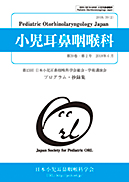Volume 30, Issue 3
Displaying 1-19 of 19 articles from this issue
- |<
- <
- 1
- >
- >|
The 4th Conference on Pediatric Otorhinolaryngology Japan
Special Lecture
-
Article type: Special Lecture
2009 Volume 30 Issue 3 Pages 187-191
Published: 2009
Released on J-STAGE: December 14, 2012
Download PDF (565K)
Education Lecture
-
Article type: Education Lecture
2009 Volume 30 Issue 3 Pages 192-195
Published: 2009
Released on J-STAGE: December 14, 2012
Download PDF (568K) -
Article type: Education Lecture
2009 Volume 30 Issue 3 Pages 196-199
Published: 2009
Released on J-STAGE: December 14, 2012
Download PDF (358K)
Symposium
-
Article type: Symposium
2009 Volume 30 Issue 3 Pages 200-205
Published: 2009
Released on J-STAGE: December 14, 2012
Download PDF (543K) -
Article type: Symposium
2009 Volume 30 Issue 3 Pages 206-211
Published: 2009
Released on J-STAGE: December 14, 2012
Download PDF (472K) -
Article type: Symposium
2009 Volume 30 Issue 3 Pages 212-216
Published: 2009
Released on J-STAGE: December 14, 2012
Download PDF (369K) -
Article type: Symposium
2009 Volume 30 Issue 3 Pages 217-221
Published: 2009
Released on J-STAGE: December 14, 2012
Download PDF (416K)
Original Articles
-
Article type: Original Article
2009 Volume 30 Issue 3 Pages 222-226
Published: 2009
Released on J-STAGE: December 14, 2012
Download PDF (473K) -
Article type: Original Article
2009 Volume 30 Issue 3 Pages 227-231
Published: 2009
Released on J-STAGE: December 14, 2012
Download PDF (464K) -
Article type: Original Article
2009 Volume 30 Issue 3 Pages 232-247
Published: 2009
Released on J-STAGE: December 14, 2012
Download PDF (763K) -
Article type: Original Article
2009 Volume 30 Issue 3 Pages 248-252
Published: 2009
Released on J-STAGE: December 14, 2012
Download PDF (373K) -
Article type: Original Article
2009 Volume 30 Issue 3 Pages 253-258
Published: 2009
Released on J-STAGE: December 14, 2012
Download PDF (712K) -
Article type: Original Article
2009 Volume 30 Issue 3 Pages 259-267
Published: 2009
Released on J-STAGE: December 14, 2012
Download PDF (483K) -
Article type: Original Article
2009 Volume 30 Issue 3 Pages 268-285
Published: 2009
Released on J-STAGE: December 14, 2012
Download PDF (513K) -
Article type: Original Article
2009 Volume 30 Issue 3 Pages 286-292
Published: 2009
Released on J-STAGE: December 14, 2012
Download PDF (384K) -
Article type: Original Article
2009 Volume 30 Issue 3 Pages 293-298
Published: 2009
Released on J-STAGE: December 14, 2012
Download PDF (346K) -
Article type: Original Article
2009 Volume 30 Issue 3 Pages 299-303
Published: 2009
Released on J-STAGE: December 14, 2012
Download PDF (378K) -
Article type: Original Article
2009 Volume 30 Issue 3 Pages 304-307
Published: 2009
Released on J-STAGE: December 14, 2012
Download PDF (236K) -
Article type: Original Article
2009 Volume 30 Issue 3 Pages 308-320
Published: 2009
Released on J-STAGE: December 14, 2012
Download PDF (526K)
- |<
- <
- 1
- >
- >|
